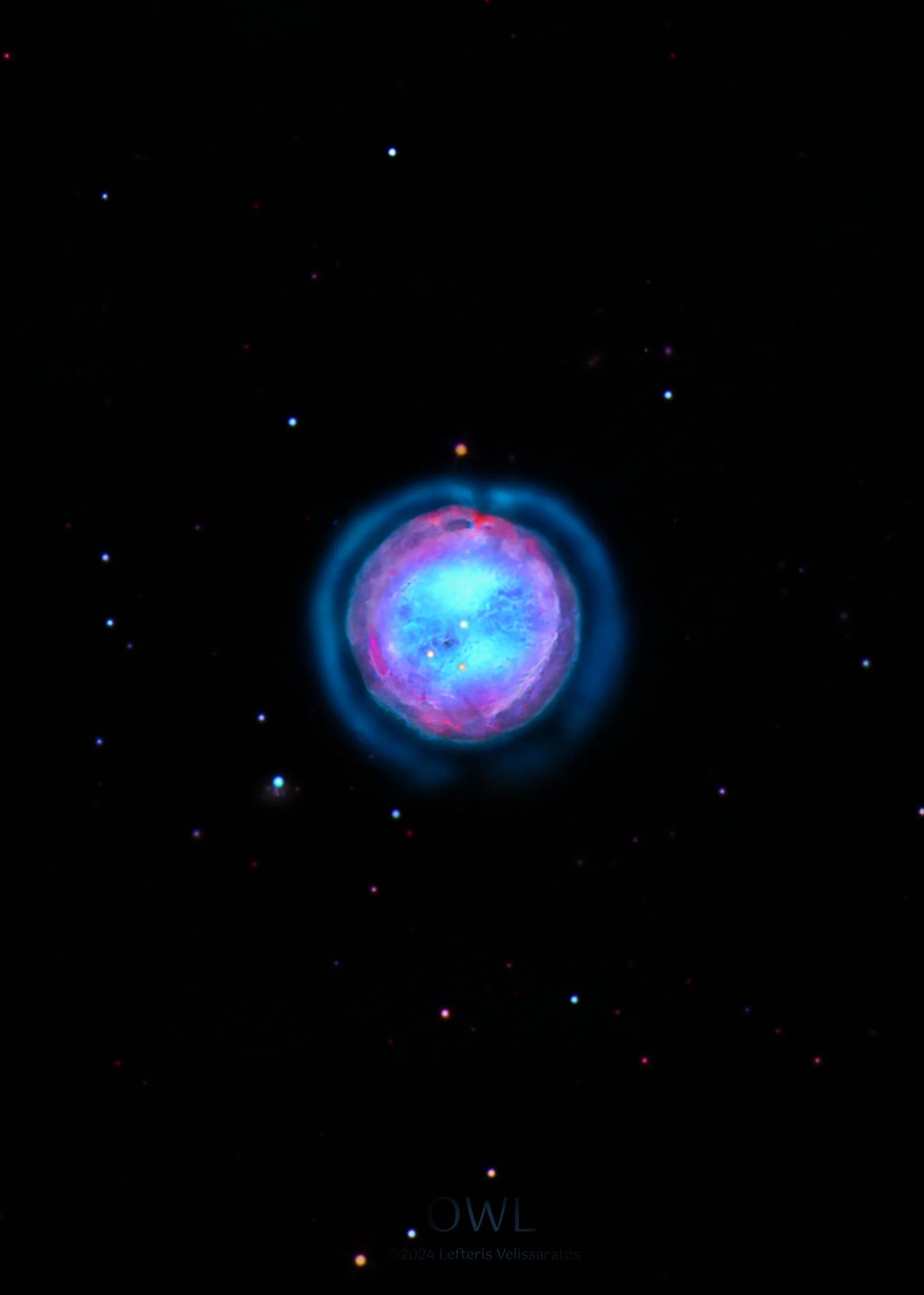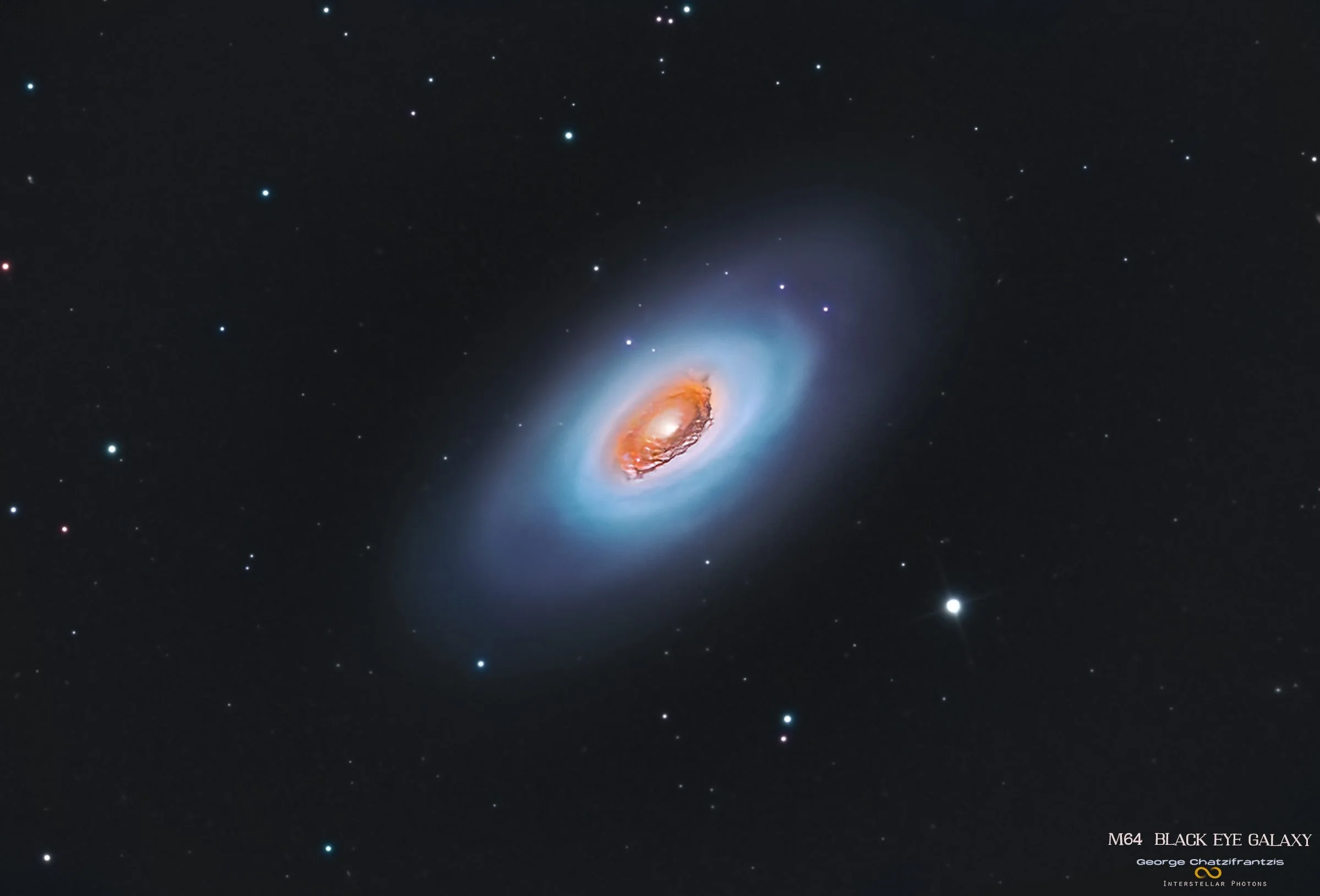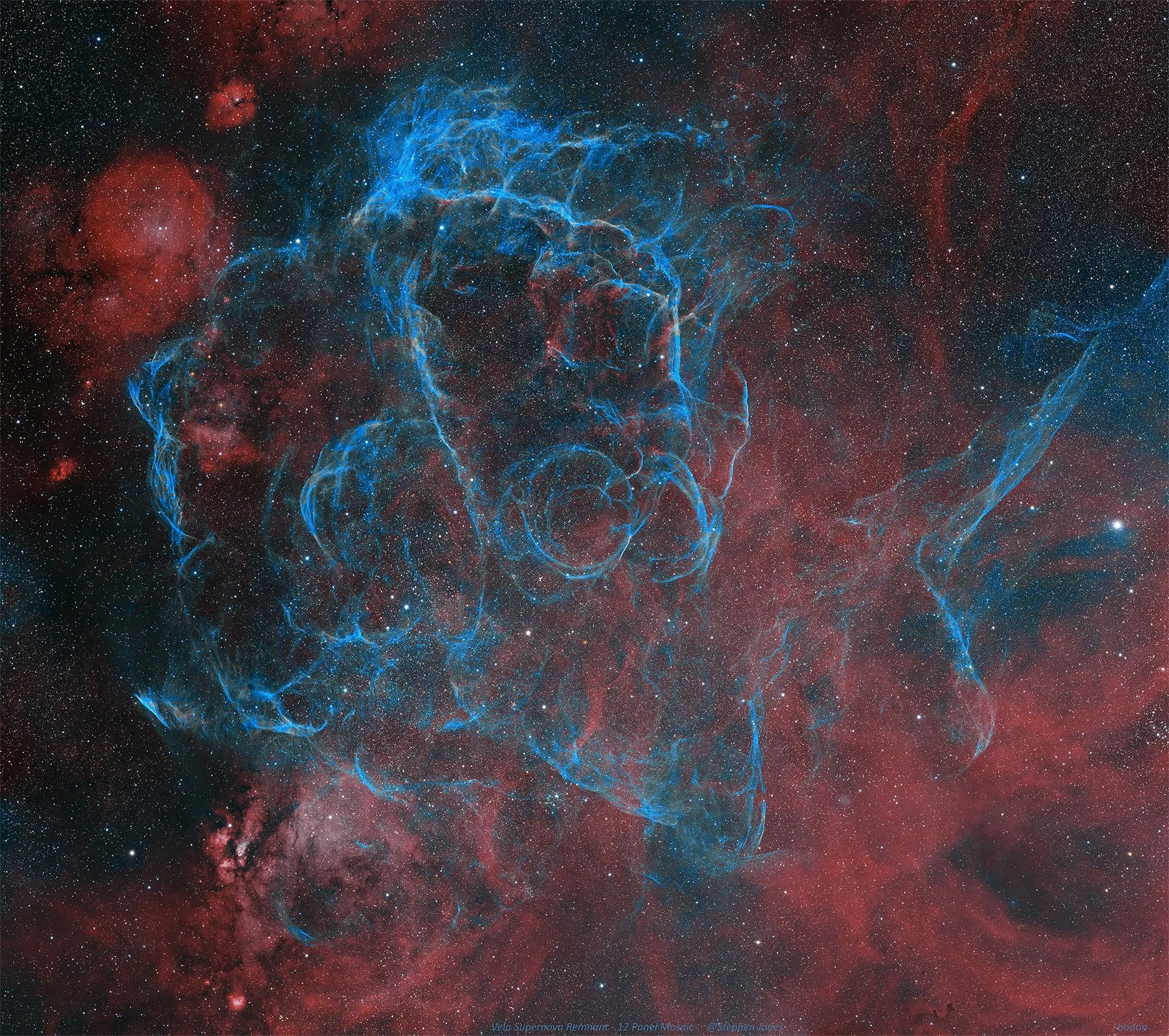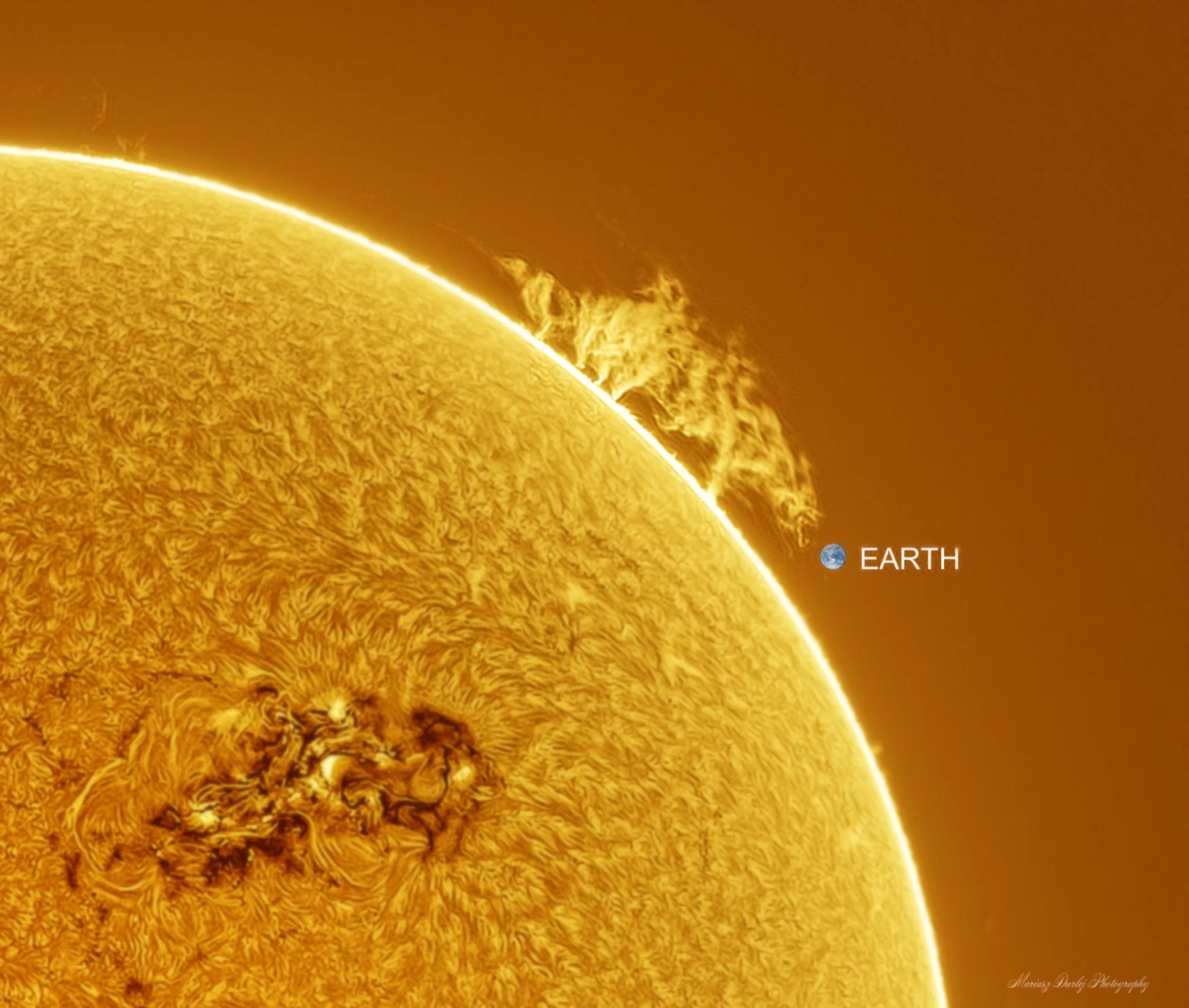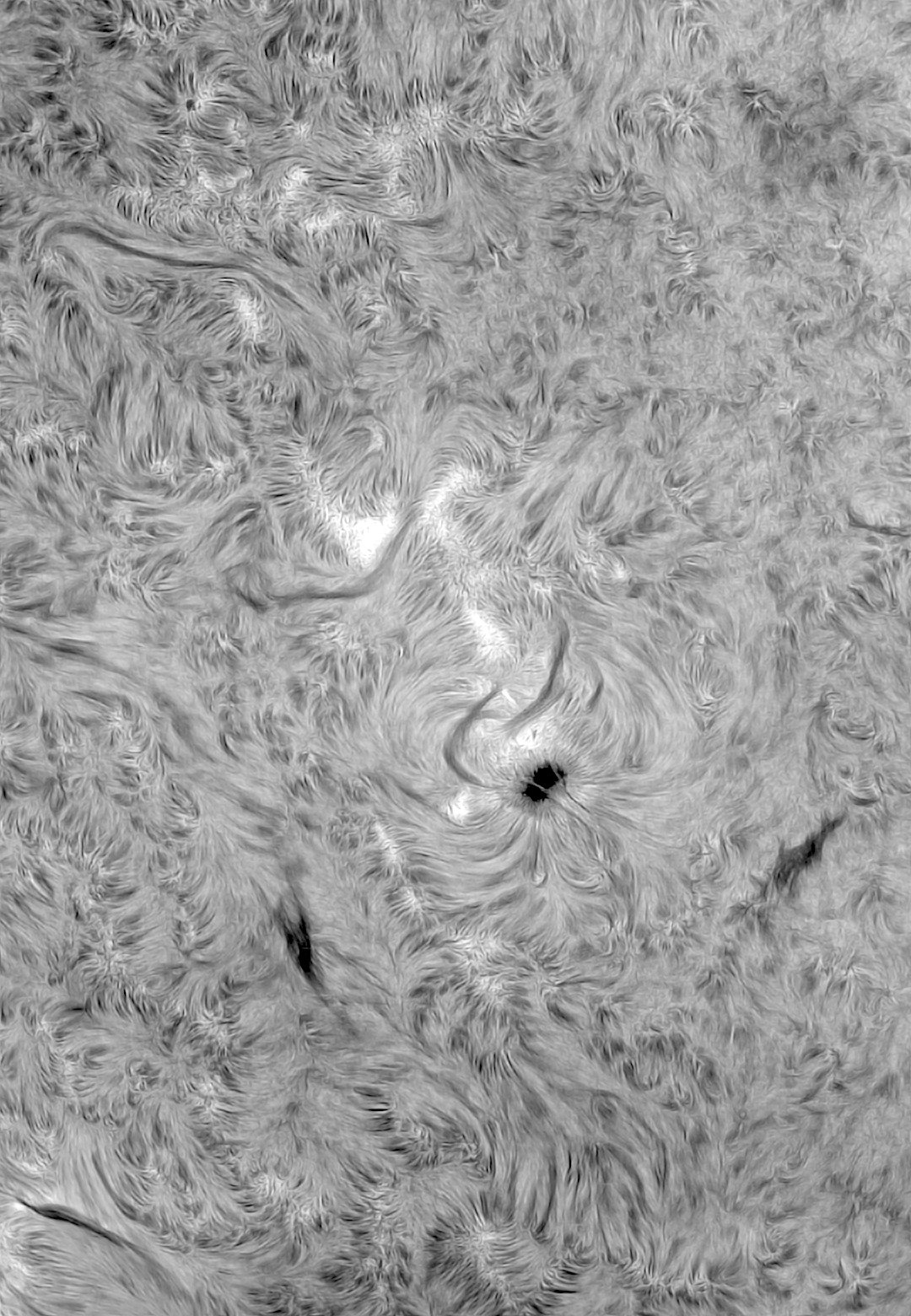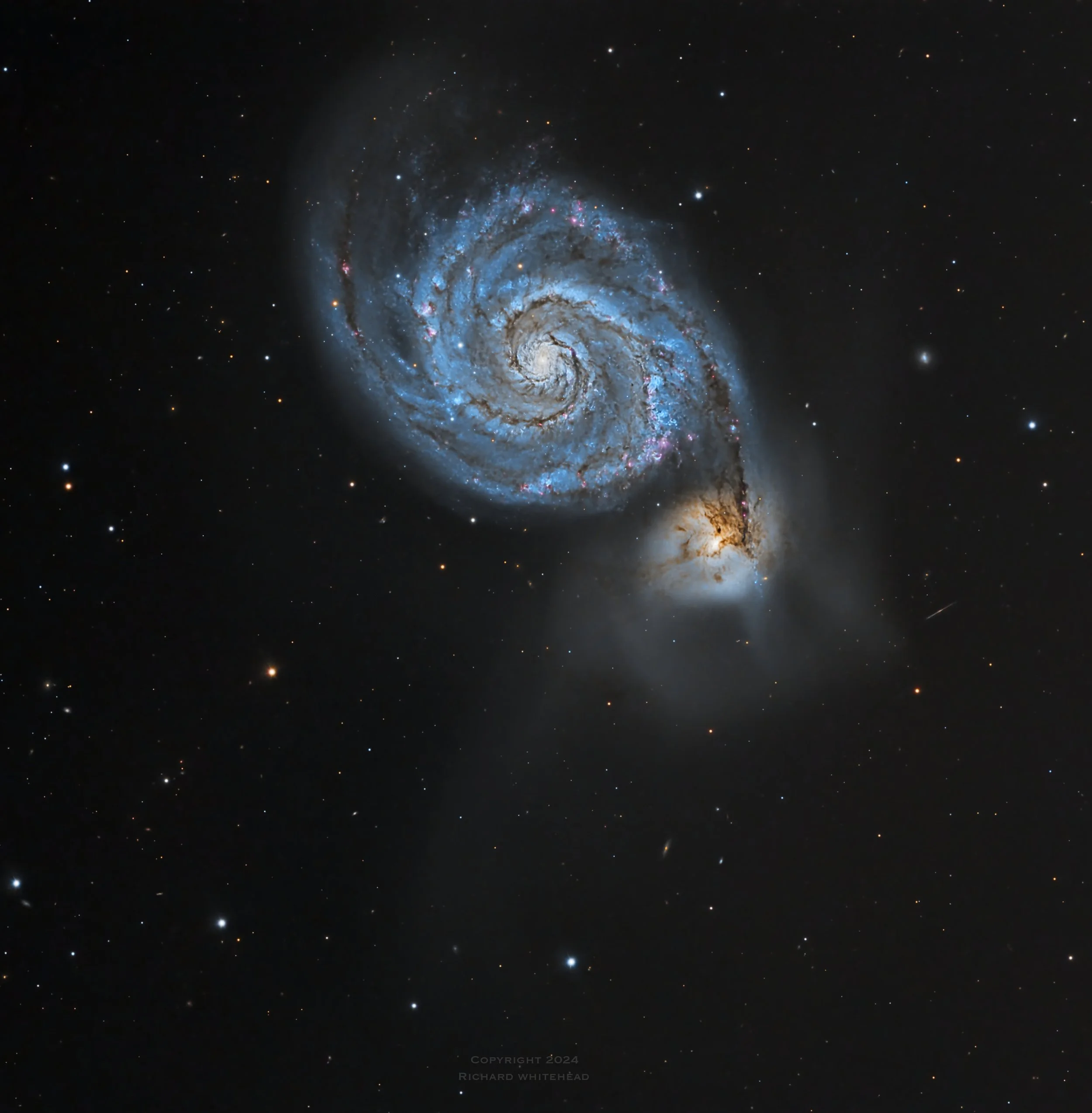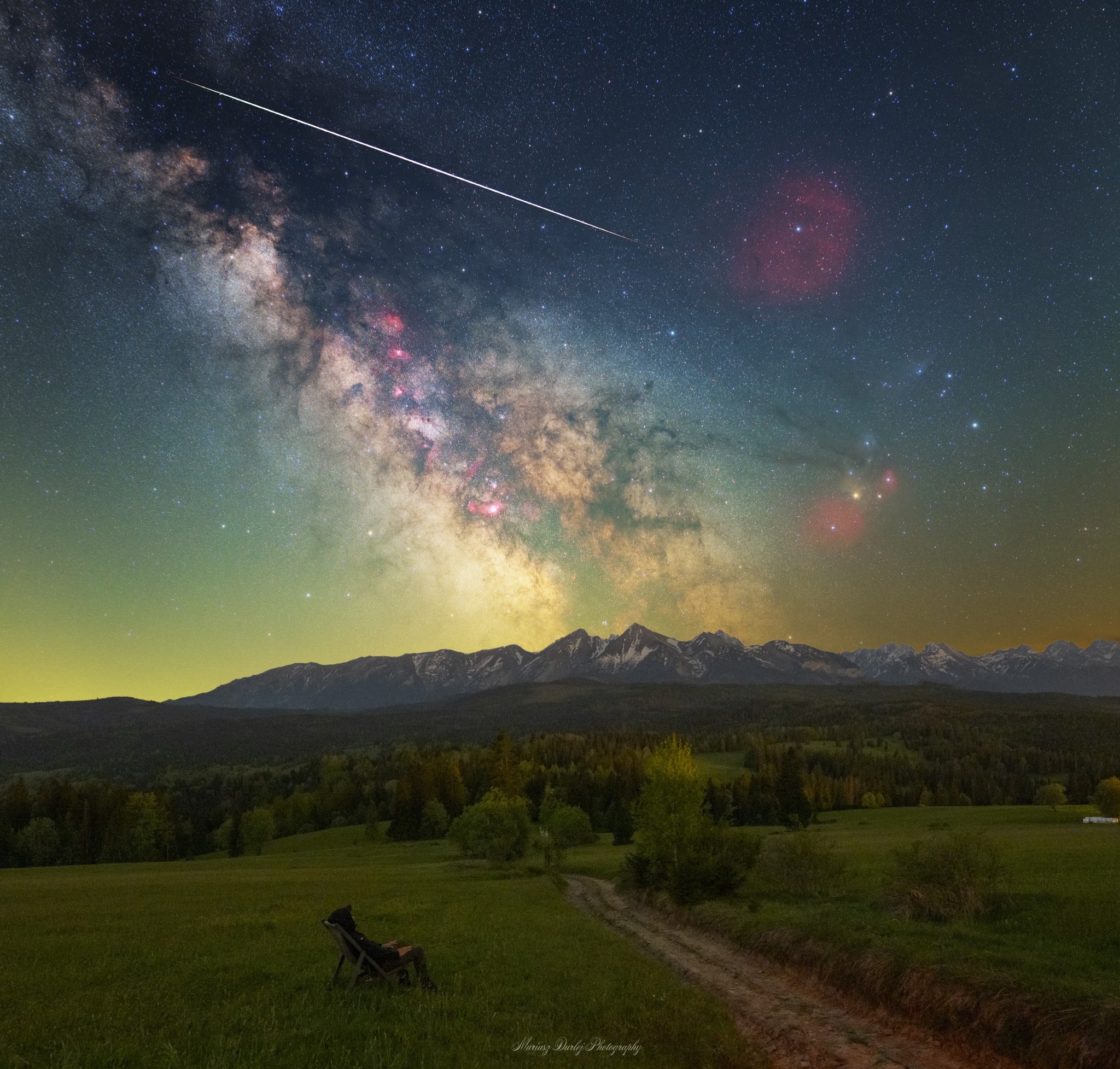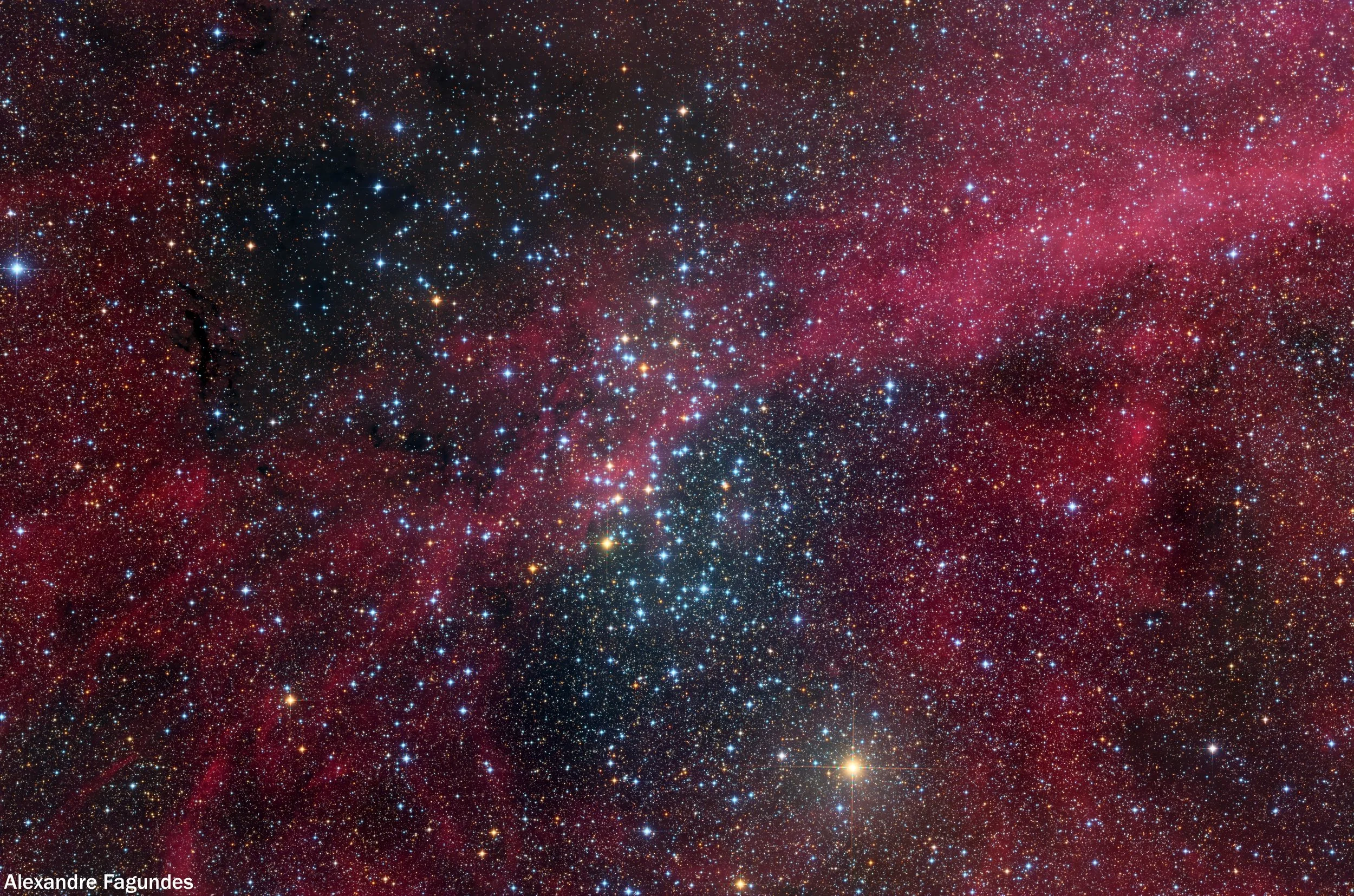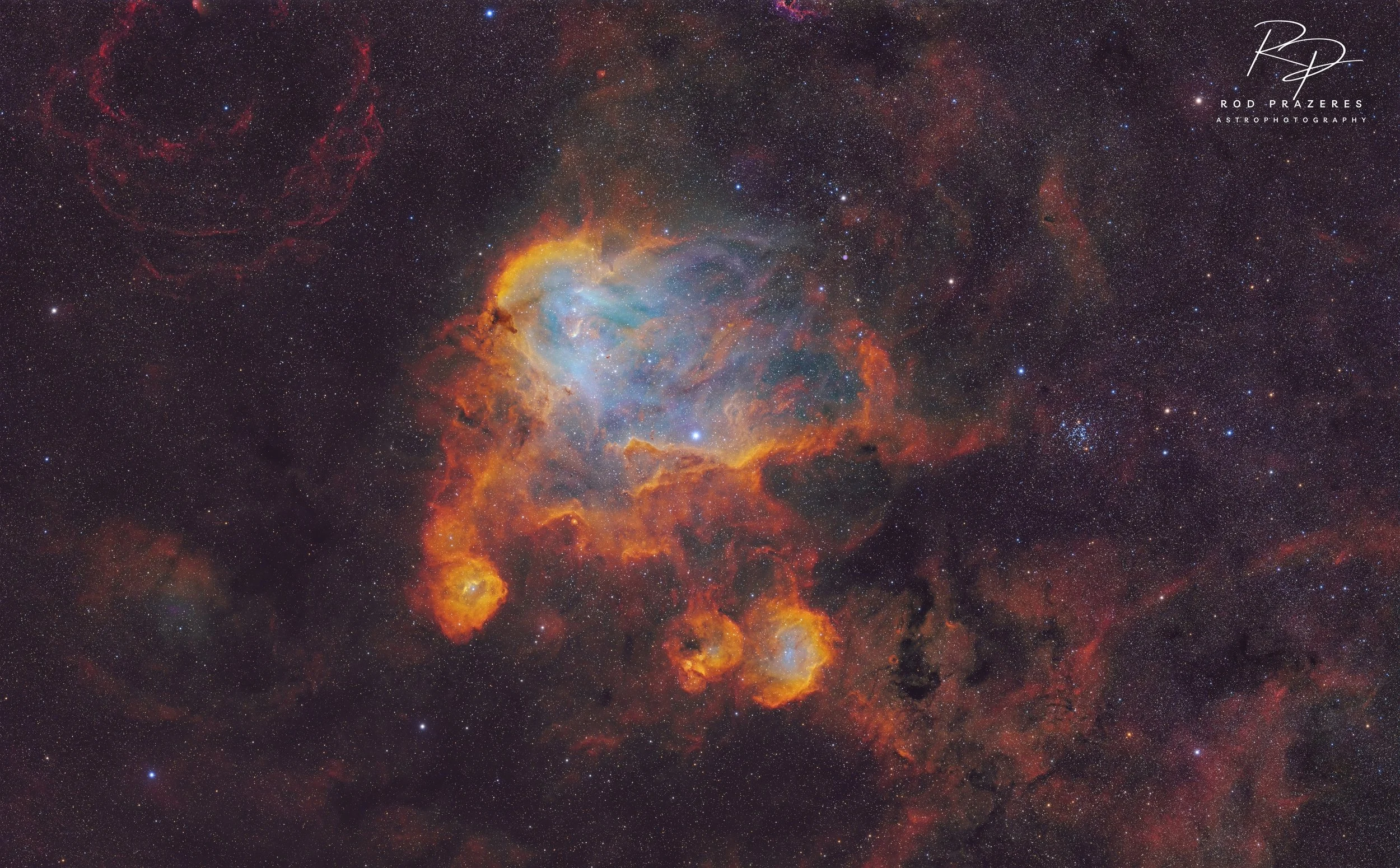
AAPOD2 Image Archives
Dragons of Ara
The Fighting Dragons of Ara, also known as NGC 6188, is a striking emission nebula located in the constellation Ara, approximately 4,000 light-years away from Earth. This nebula gets its dramatic name from the visually striking shapes formed by its dark dust lanes and glowing gas, resembling two dragons engaged in combat. The region is rich in hydrogen gas, which is ionized by the intense ultraviolet radiation from nearby young, massive stars, causing it to glow brightly in red and pink hues.
NGC 6188 is situated near the open star cluster NGC 6193, whose hot, young stars are responsible for illuminating the nebula. This star-forming region is part of the larger Ara OB1 association, a group of young, massive stars that have recently formed from the same molecular cloud. The interplay between the intense radiation from these stars and the surrounding gas and dust creates a dynamic and evolving landscape, offering astronomers a spectacular view of stellar birth and the complex interactions within nebulae. The intricate structures and vibrant colors of the Fighting Dragons of Ara make it a favorite target for astrophotographers and a valuable object of study for understanding star formation processes.
NGC 2403 spiral galaxy
NGC 2403 is a prominent spiral galaxy located in the constellation Camelopardalis, approximately 10 million light-years from Earth. As a member of the M81 Group, NGC 2403 shares similarities with the nearby Andromeda Galaxy (M31), including its spiral structure and rich star-forming regions. This galaxy is noted for its numerous H II regions, which are large clouds of ionized hydrogen where new stars are born, making it a vibrant and active site of stellar formation.
One of the most striking features of NGC 2403 is its well-defined spiral arms, which are adorned with clusters of young, hot stars and bright nebulae. These features make NGC 2403 an excellent subject for studying the processes of star formation and the dynamics of spiral galaxies. Additionally, NGC 2403 has been the site of several supernovae, most notably SN 1954J and SN 2004dj, providing valuable data on the life cycles of stars and the chemical enrichment of galaxies. Its relative proximity and brightness allow astronomers to study its properties in great detail, enhancing our understanding of spiral galaxy evolution.
GALAXY NGC4395 IN CANES VENATICI
NGC 4395 is a unique and intriguing galaxy located in the constellation Canes Venatici, approximately 14 million light-years from Earth. Unlike many well-known galaxies, NGC 4395 is classified as a low surface brightness galaxy and lacks the prominent spiral arms that characterize more typical spiral galaxies. Its diffuse and irregular appearance makes it an interesting subject of study, particularly for understanding the variety of galactic structures and formations in the universe.
One of the most remarkable features of NGC 4395 is its low-mass central black hole, estimated to be around 10,000 times the mass of the Sun. This black hole is one of the smallest supermassive black holes known, providing valuable insights into the lower end of the supermassive black hole mass spectrum and its impact on the host galaxy. NGC 4395 also exhibits active galactic nucleus (AGN) activity, emitting X-rays and ultraviolet light, which offers a unique opportunity to study the relationship between black holes and galaxy formation in environments with minimal stellar activity.
The OWL Extended Version
The Owl Nebula, also known as Messier 97 (M97), is a captivating planetary nebula located in the constellation Ursa Major, approximately 2,030 light-years from Earth. Named for its resemblance to an owl's face, with two dark circular features resembling eyes, M97 is one of the more complex and studied planetary nebulae. This nebula represents the final stages of a star similar in mass to our Sun, which has expelled its outer layers, leaving behind a hot, dense white dwarf at its center.
M97 spans about 3.4 light-years in diameter and is notable for its intricate structure and varying emission lines, which provide insights into the composition and dynamics of the ejected material. The "eyes" of the Owl Nebula are believed to be regions with less dense gas, allowing us to see deeper into the nebula. Observations in various wavelengths, including optical and infrared, have revealed details about the chemical abundances and physical conditions within M97, offering valuable clues about the processes involved in the late evolutionary stages of stars.
M64 Black Eye Galaxy
M64, commonly known as the Black Eye Galaxy, is a striking spiral galaxy located approximately 17 million light-years away in the constellation Coma Berenices. It earns its evocative nickname from the prominent dark dust lane that obscures part of its bright nucleus, creating the appearance of a cosmic black eye. This galaxy is particularly notable for its unusual internal dynamics, with the outer regions rotating in the opposite direction to the inner regions, suggesting a past galactic merger or interaction.
The Black Eye Galaxy is a site of active star formation, particularly in the regions around the dark dust lane. Observations reveal a rich mix of young, hot stars and older stellar populations, providing valuable insights into the processes of galactic evolution and star formation. The contrasting regions of darkness and light within M64 make it a visually captivating and scientifically intriguing object for both amateur and professional astronomers.
12 Panel Mosaic of Vela Supernova Remnant
Embark on a scientific exploration of the Vela Supernova Remnant through this stunning 12-panel mosaic capturing its intricate details and expansive reach. This cosmic masterpiece, born from the remnants of a stellar explosion, spans a vast portion of the sky, showcasing its complex structure and dynamic interplay with the surrounding interstellar medium.
Each panel of this mosaic offers a glimpse into different regions of the Vela Supernova Remnant, revealing filaments, shockwaves, and intricate patterns of glowing gas and dust. With meticulous attention to detail, this mosaic provides astronomers and enthusiasts alike with a deeper understanding of the supernova's aftermath and its ongoing evolution over thousands of years.
Northern Lights over the Po Valley
Aurora week continues! Indeed, the mesmerizing Northern Lights graced the Po Valley following a powerful solar storm this weekend. This rare event brought the captivating aurora borealis to an area not typically associated with such celestial displays, adding an extra layer of awe and wonder to the night sky above the valley.
Aurora Borealis Frontignano di Ussita ITALY
In the typically serene skies of Frontignano di Ussita (MC), the appearance of a sudden and spectacular Aurora Borealis is a rare and remarkable event. Against this backdrop, the captivating display of lights painted a vivid tapestry across the heavens. The moment was skillfully captured using a tripod-mounted Canon EOS 600D camera paired with a Samyang 14mm lens, with a 15-second exposure at ISO 800, immortalizing the ephemeral beauty of the aurora in the night sky.
Sun with sunspot 3664 and solar prominences
Captured amidst the vast expanse of space, the Sun shines as a radiant sphere of light and energy, showcasing intricate details of its dynamic surface. Amidst the swirling maelstrom of solar activity, Sunspot 3664 emerges as a LARGE darkened blemish on the Sun's photosphere, signifying regions of intense magnetic activity. These sunspots are cooler areas on the Sun's surface, caused by concentrated magnetic fields inhibiting the flow of heat, creating a stark contrast against the surrounding brilliance.
Accompanying this celestial display are solar prominences, towering arcs of plasma that extend high above the Sun's surface, reaching heights of tens of thousands of kilometers. These fiery tendrils of ionized gas, sculpted by the Sun's magnetic field, mesmerize observers with their graceful dance across the solar limb. As the Sun rotates and evolves, these prominences continually shift and change, providing astronomers with valuable insights into the Sun's dynamic behavior and the nature of its magnetic environment. Through careful observation and scientific inquiry, we continue to unravel the mysteries of our nearest star, the life-giving Sun, and its profound influence on the cosmos.
The magnificent Sombrero galaxy (M104)
The Sombrero Galaxy, also known as Messier 104 or M104, stands as a celestial marvel in the constellation Virgo, captivating astronomers and stargazers alike with its distinctive appearance. This stunning spiral galaxy boasts a prominent dark dust lane that bisects its bright central bulge, resembling the brim of a sombrero hat, from which it derives its name. Located approximately 28 million light-years away from Earth, M104 spans about 50,000 light-years in diameter, making it one of the most massive galaxies in the nearby universe.
Its striking appearance is further accentuated by a vibrant halo of globular clusters, open clusters, and young blue stars that adorn its spiral arms, contributing to its overall grandeur. While its central bulge harbors a supermassive black hole, which is estimated to be about 1 billion times the mass of the Sun, the Sombrero Galaxy continues to intrigue scientists with its intricate structure and evolutionary history. Through the lens of telescopes and the wonders of astrophotography, M104 offers a glimpse into the cosmic ballet of galaxies, inspiring awe and curiosity about the mysteries of the universe.
SUN
On May 6, 2024, at 10:30 a.m., a captivating glimpse of the solar photosphere was captured, revealing intricate details of our nearest star's surface. The photo showcases the dynamic and ever-changing nature of the Sun, with prominent features such as sunspots, granules, and faculae dotting its fiery surface.
Sunspots, dark regions caused by intense magnetic activity, stand out against the brighter background of the photosphere. These cooler areas are often associated with increased solar activity and can persist for days or even weeks before fading away. Meanwhile, granules, small cellular structures that form as hot plasma rises and cools on the Sun's surface, create a textured appearance reminiscent of a bubbling cauldron. Interspersed among these granules are faculae, bright patches that indicate regions of enhanced magnetic activity and are often found near sunspots. This mesmerizing image offers a glimpse into the dynamic and complex nature of our Sun, reminding us of its vital role in sustaining life on Earth while captivating our imagination with its celestial beauty.
M51 and distant background Galaxies
The iconic whirlpool galaxy, M51, takes center stage in this stunning astrophotograph, surrounded by a backdrop of distant background galaxies. Located approximately 23 million light-years away in the constellation Canes Venatici, M51 showcases its spiral arms adorned with bright knots of star formation and intricate dust lanes. Its gravitational influence is evident as it interacts with smaller companion galaxies, creating tidal tails and triggering bursts of new stellar activity.
Amidst the serene expanse of space, the faint glimmers of distant background galaxies add depth to the cosmic tapestry. Each speck of light represents a distant island universe, billions of light-years away from our own Milky Way galaxy. Together, they form a breathtaking vista of celestial splendor, inviting viewers to contemplate the vastness of the cosmos and the interconnectedness of galaxies across the universe.
Fireball over the Bielskie Tatra Mountains
A spectacular fireball streaks across the night sky above the Bielskie Tatra Mountains, leaving a trail of brilliance in its wake. This captivating scene captures the fleeting yet mesmerizing beauty of a meteor as it blazes through Earth's atmosphere. The Bielskie Tatra Mountains provide a dramatic backdrop for this celestial spectacle, their rugged peaks standing in stark contrast to the serene night sky.
As the fireball illuminates the darkness, it serves as a reminder of the dynamic and ever-changing nature of our universe. Meteor showers like this one offer astronomers and enthusiasts alike the opportunity to witness the remnants of cosmic debris interacting with our atmosphere, creating dazzling displays of light. Moments like these inspire wonder and curiosity, encouraging us to gaze skyward and contemplate the mysteries of the cosmos.
The Grand Spiral Galaxy M100 (NGC 4321)
M100, also known as NGC 4321, stands as a majestic example of a grand spiral galaxy, nestled within the constellation Coma Berenices. With its sweeping spiral arms and bright core, M100 exhibits intricate patterns of star formation and stellar activity across its vast expanse. Spanning approximately 107,000 light-years in diameter, M100 ranks among the largest galaxies in the Virgo Cluster, a rich cluster of galaxies located some 55 million light-years away from Earth.
As one of the brightest members of the Virgo Cluster, M100 offers astronomers a wealth of insights into the dynamics of galactic evolution. Its spiral arms are adorned with regions of intense star formation, where massive stars are born from the gravitational collapse of dense molecular clouds. Additionally, M100 harbors a supermassive black hole at its center, whose gravitational influence shapes the galaxy's structure and influences its surrounding environment. By studying galaxies like M100, astronomers gain valuable knowledge about the processes driving the formation and evolution of galaxies throughout the universe.
Badwater Salt Flats Milky Way reflection
The Badwater Basin in Death Valley National Park, California, is renowned for its stunning salt flats, which become a mesmerizing canvas under the starry night sky. In this captivating image, the Milky Way casts its radiant glow over the vast expanse of the salt flats, creating a mirror-like reflection on the shimmering surface below.
As one of the lowest points in North America, the Badwater Basin offers an ideal vantage point for observing the Milky Way's celestial spectacle. The reflection of the Milky Way in the shallow pools of water left behind by occasional rain showers adds an ethereal quality to the scene, enhancing the otherworldly beauty of the landscape. This striking image serves as a reminder of the extraordinary wonders that can be found in the natural world, inviting viewers to marvel at the beauty of the cosmos and the Earth's own remarkable features.
M13 Hercules' Diamonds
M13, also known as the Great Globular Cluster in Hercules, is one of the most remarkable objects in the northern sky. Situated in the constellation Hercules, this globular cluster is a densely packed sphere of hundreds of thousands of stars held together by gravity. Its compact core shines brilliantly, while its outer regions extend in a vast halo of fainter stars.
Located approximately 22,200 light-years away from Earth, M13 is one of the brightest and largest globular clusters visible from the Northern Hemisphere. Its age is estimated to be around 12 to 13 billion years old, making it one of the oldest known objects in the Milky Way galaxy. Studying M13 provides astronomers with valuable insights into the formation and evolution of globular clusters, offering a window into the early history of our galaxy.
M 25 - bright and colorful stars in front of a sea of stars
M25, also known as the IC 4725 open cluster, is a dazzling assembly of stars situated in the constellation Sagittarius. This cluster shines brightly against the backdrop of the Milky Way, appearing like a jewel in the night sky. Comprising hundreds of stars, M25 presents a breathtaking display of stellar diversity, with stars of various colors and magnitudes dotting its celestial canvas.
The cluster's proximity to the galactic plane makes it immersed in a sea of stars, enhancing its visual appeal and creating a mesmerizing tapestry of light. With its rich concentration of stars and intricate patterns, M25 offers astronomers and stargazers alike a captivating glimpse into the beauty and complexity of our galaxy.
Wishing Well Cluster (NGC 3532)
Discover the Wishing Well Cluster, also known as NGC 3532, a dazzling open star cluster located in the constellation Carina. This celestial gem is situated approximately 1,300 light-years away from Earth, nestled within the rich star fields of the southern sky.
NGC 3532 earned its charming moniker due to its resemblance to a well filled with stars, evoking a sense of wonder and imagination. With an estimated age of around 300 million years, this cluster boasts a diverse population of stars, ranging from hot, young blue stars to cooler, older yellow and red giants. Its radiant glow and stellar diversity make NGC 3532 a captivating sight for stargazers and astronomers alike, offering a glimpse into the vibrant tapestry of the cosmos.
"Radiant Canopy": The Lustrous Realms of the Running Chicken Nebula
The Running Chicken Nebula, formally known as IC 2944, is a star-forming region located in the constellation Centaurus. Resembling a chicken running through space, this striking nebula is a vibrant tapestry of gas and dust, illuminated by the intense radiation of young, hot stars nestled within its midst. Stretching across approximately 100 light-years, IC 2944 is part of a larger complex of star-forming regions in the Centaurus OB association.
This captivating nebula is a prime example of the dynamic processes shaping our universe, where stellar winds and radiation from massive stars sculpt the surrounding gas clouds, giving rise to intricate structures and fostering the birth of new stars. Its distinct appearance has earned it a place among the most iconic and visually stunning objects in the southern sky, captivating astronomers and stargazers alike with its celestial charm.
Orion Delta
Armature Astronomers have made an astonishing discovery in the Orion constellation. After minutes of careful observation, a fourth star has been detected within Orion's famous belt, joining the familiar trio of bright stars. This newfound addition has sent shockwaves through the astronomical community, challenging our understanding of stellar formation and constellation dynamics.




